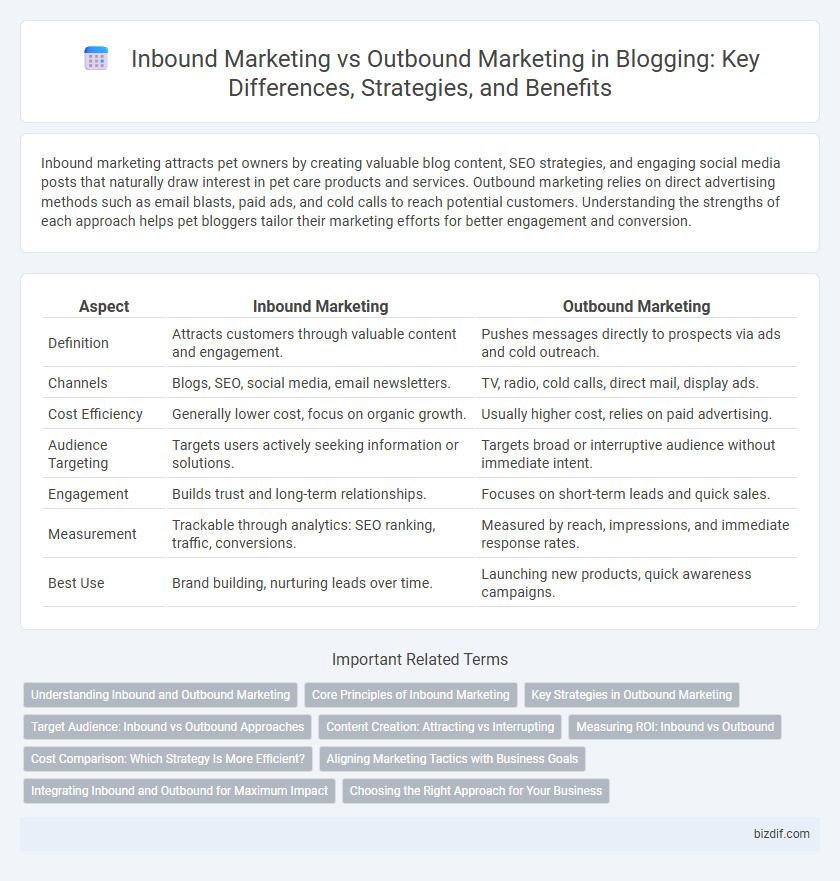Inbound marketing attracts pet owners by creating valuable blog content, SEO strategies, and engaging social media posts that naturally draw interest in pet care products and services. Outbound marketing relies on direct advertising methods such as email blasts, paid ads, and cold calls to reach potential customers. Understanding the strengths of each approach helps pet bloggers tailor their marketing efforts for better engagement and conversion.
Table of Comparison
| Aspect | Inbound Marketing | Outbound Marketing |
|---|---|---|
| Definition | Attracts customers through valuable content and engagement. | Pushes messages directly to prospects via ads and cold outreach. |
| Channels | Blogs, SEO, social media, email newsletters. | TV, radio, cold calls, direct mail, display ads. |
| Cost Efficiency | Generally lower cost, focus on organic growth. | Usually higher cost, relies on paid advertising. |
| Audience Targeting | Targets users actively seeking information or solutions. | Targets broad or interruptive audience without immediate intent. |
| Engagement | Builds trust and long-term relationships. | Focuses on short-term leads and quick sales. |
| Measurement | Trackable through analytics: SEO ranking, traffic, conversions. | Measured by reach, impressions, and immediate response rates. |
| Best Use | Brand building, nurturing leads over time. | Launching new products, quick awareness campaigns. |
Understanding Inbound and Outbound Marketing
Inbound marketing focuses on attracting potential customers through content creation, SEO, and social media engagement, allowing for organic lead generation and higher audience trust. Outbound marketing involves proactive outreach methods such as cold calling, direct mail, and paid advertisements to push messages directly to a target audience. Understanding inbound and outbound marketing helps businesses allocate resources effectively to balance brand awareness and lead conversion strategies.
Core Principles of Inbound Marketing
Inbound marketing centers on attracting potential customers through valuable content, personalized experiences, and SEO-driven strategies that address user intent and needs. It emphasizes building trust and long-term relationships via blog posts, social media engagement, and lead nurturing through email campaigns. This customer-centric approach contrasts with outbound marketing's interruption-based tactics by fostering organic traffic and qualified leads.
Key Strategies in Outbound Marketing
Outbound marketing strategies primarily focus on direct outreach tactics such as cold calling, email blasts, and paid advertisements on platforms like Google Ads and Facebook Ads. These approaches aim to capture audience attention through broad targeting and interruptive messaging, ensuring immediate visibility. Emphasizing high-frequency exposure and repetitive messaging helps brands generate quick leads and increase overall market penetration.
Target Audience: Inbound vs Outbound Approaches
Inbound marketing targets specific audiences by creating valuable content that attracts and engages users organically through channels like blogs, social media, and SEO. Outbound marketing focuses on a broader audience using direct methods such as cold calls, email blasts, and advertisements to capture attention. Understanding the differences in audience targeting helps marketers optimize strategies for higher engagement and conversion rates.
Content Creation: Attracting vs Interrupting
Inbound marketing leverages content creation to attract and engage target audiences by providing valuable information that addresses their needs and interests, fostering trust and long-term relationships. Outbound marketing relies on interruptive tactics such as cold calls, display ads, or spam emails that disrupt the audience's experience without prior consent, often resulting in lower engagement rates. Effective inbound strategies prioritize SEO-optimized blogs, videos, and social media posts to naturally draw potential customers, whereas outbound marketing focuses on pushing messages to a broad, less targeted audience.
Measuring ROI: Inbound vs Outbound
Measuring ROI in inbound marketing relies heavily on metrics such as lead quality, conversion rates, content engagement, and customer lifetime value, leveraging tools like Google Analytics and marketing automation platforms for precise tracking. Outbound marketing ROI measurement often focuses on direct response rates, cost per acquisition, and overall campaign reach, using metrics from television, radio, and print advertising alongside digital ad platforms. Data-driven analysis shows inbound marketing typically delivers higher long-term ROI due to targeted audience engagement and lower cost per lead compared to outbound strategies.
Cost Comparison: Which Strategy Is More Efficient?
Inbound marketing typically offers a more cost-efficient strategy compared to outbound marketing, often costing 61% less per lead according to HubSpot research. This efficiency stems from inbound's focus on content creation, SEO, and organic audience growth, reducing the need for expensive ad placements and interruptions. Outbound marketing, involving paid ads, cold calls, and direct mail, generally incurs higher upfront costs with lower conversion rates, making it less cost-effective for sustained lead generation.
Aligning Marketing Tactics with Business Goals
Aligning marketing tactics with business goals requires understanding the distinct advantages of inbound and outbound marketing strategies. Inbound marketing attracts qualified leads through content creation, SEO, and social media engagement, making it ideal for long-term brand growth and customer relationship building. Outbound marketing uses targeted advertising and direct outreach to generate immediate sales, aligning well with businesses seeking quick market penetration and short-term results.
Integrating Inbound and Outbound for Maximum Impact
Integrating inbound and outbound marketing strategies creates a synergistic effect that amplifies brand visibility and lead generation by combining targeted content creation with proactive outreach efforts. Leveraging data analytics to align outbound campaigns with inbound insights enhances audience segmentation and personalization, driving higher engagement and conversion rates. Businesses that seamlessly blend SEO-optimized blog content and paid advertisements experience improved ROI through consistent messaging across multiple channels.
Choosing the Right Approach for Your Business
Inbound marketing leverages content creation, SEO, and social media to attract qualified leads by providing valuable information tailored to target audiences, resulting in higher engagement and conversion rates. Outbound marketing relies on traditional advertising methods such as cold calls, email blasts, and paid ads to push messages to a broader but less targeted audience, often leading to higher costs with lower ROI. Businesses must evaluate their goals, budget, and customer behavior to decide whether a focused inbound strategy or a broad outbound campaign better aligns with their growth objectives.
Inbound Marketing vs Outbound Marketing Infographic

 bizdif.com
bizdif.com